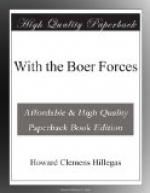[Illustration: THE AUTHOR, AND A BASUTO PONY WHICH ASSISTED IN THE FIGHT AT SANNASPOST]
Until the officer advised his men to retreat and he himself fell from his horse the main body of the British troops was ignorant of the presence of the Boers, but the report of the rifle was a summons to battle and instantly the field was filled with myriads of stirring scenes. The lazy transport-train suddenly became a thing of rapid motion; the huge body of troops was quickly broken into many parts; horses that had been idling along the road plunged forward as if projected by catapults. Officers with swords flashing in the sunlight appeared leading their men into different positions, cannon were hurriedly drawn upon commanding elevations, and Red Cross waggons scattered to places of safety. The peaceful transport-train had suddenly been transformed into a formidable engine of war by the report of a rifle, and the contest for a sentiment and a bit of ground was opened by shrieking cannon-shell and the piercing cry of rifle-ball.
Down at the foot of the slope, where the drift crossed the spruit, Boers were dragging cannon into position, and in among the waggons which had become congested in the road, burghers and soldiers were engaging in fierce hand-to-hand encounters. A stocky Briton wrestled with a youthful Boer, and in the struggle both fell to the ground; near by a cavalryman was firing his revolver at a Boer armed with a rifle, and a hundred paces away a burgher was fighting with a British officer for the possession of a sword. Over from the hills in the south came the dull roar of Boer cannon, followed by the reports of the shells exploding in the east near the waterworks. British cannon opened fire from a position near the white smoke-stack and scores of bursting projectiles fell among the waggons at the spruit. Oxen and horses were rent limb from limb, waggons tumbled over on their sides; boxes of provisions were thrown in all directions, and out of the cloud of dust and smoke stumbled men with blood-stained faces and lacerated bodies. Terrified and bellowing oxen twisted and tugged at their yokes; horses broke from their fastenings in the waggons and dashed hither and thither, and weakling donkeys strove in vain to free themselves from waggons set on fire by the shells. Explosion followed explosion, and with every one the mass became more entangled. Dead horses fell upon living oxen; wheels and axles were thrown on the backs of donkeys, and plunging mules dragged heavy waggons over great piles of debris.
The cannon on the southern hills became more active and their shells caused the landscape surrounding the waterworks to be filled with geysers of dust. Troops which were stationed near the white smoke-stack suddenly spurred their horses forward and dashed northward to seek safety behind a long undulation in the ground. The artillerymen in the hills followed their movements with shells, and the dust-fountains sprang up at the




